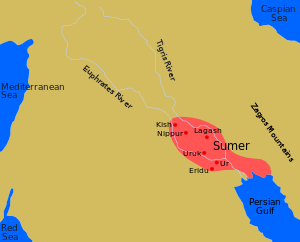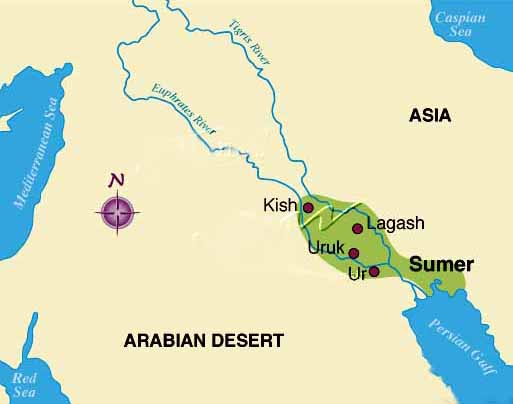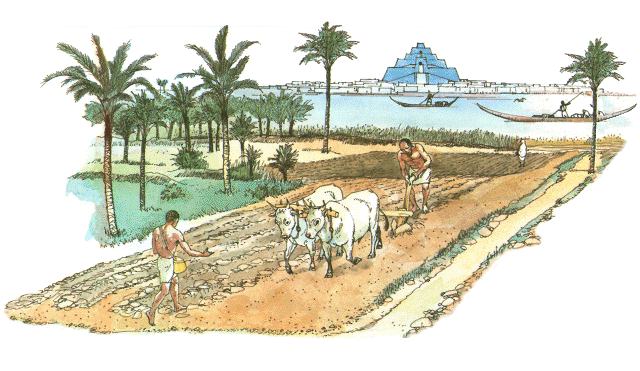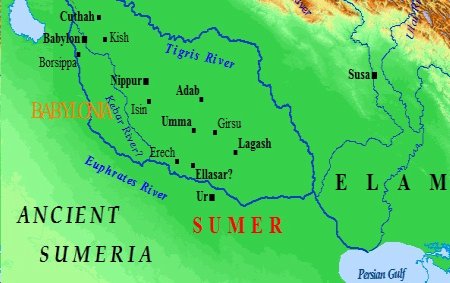



Text source: Wikipedia
KISH
Kish (Sumerian: Kiإ،; transliteration: Kiإki; cuneiform: ;[1] Akkadian: kiإ،إ،atu[2]) is modern Tell al-Uhaymir (Babil Governorate, Iraq), and was an ancient city ofSumer. Kish is located some 12 km east of Babylon, and 80 km south of Baghdad (Iraq).
History
Kish was occupied beginning in the Jemdet Nasr period (ca. 3100 BC), gaining prominence as one of the pre-eminent powers in the region during the early dynastic period. The Sumerian king list states that it was the first city to have kings following the deluge,[3] beginning with Jushur. Jushur's successor is called Kullassina-bel, but this is actually a sentence in Akkadian meaning "All of them were lord". Thus, some scholars have suggested that this may have been intended to signify the absence of a central authority in Kish for a time. The names of the next nine kings of Kish preceding Etana are all Akkadian words for animals, e.g. Zuqaqip "scorpion". The Semitic nature of these and other early names associated with Kish reveals that its population had a strong Semitic component from the dawn of recorded history.[4]
The 12th king of Kish appearing on the list, Etana, is noted as "the shepherd, who ascended to heaven and consolidated all the foreign countries". Although his reign has yet to be archaeologically attested, his name is foundin later legendary tablets, and Etana is sometimes regarded as the first king and founder of Kish himself. The 21st king of Kish on the list, Enmebaragesi, said to have captured the weapons of Elam, is the first name confirmed by archaeological finds from his reign. He is also known through other literary references, where he and his son Aga of Kish are portrayed as contemporary rivals of Dumuzid, the Fisherman and Gilgamesh, early rulers of Uruk.
Some early kings of Kish are known through archaeology, but are not named on the King list. These include Utug or Uhub, said to have defeated Hamazi in the earliest days, and Mesilim, who built temples in Adab andLagash, where he seems to have exercised some control.
The Third Dynasty of Kish is unique in that it begins with a woman, previously a tavern keeper, Kubau, as "king". She was later deified as the goddess Kheba. Afterwards, though its military and economic power was diminished, it retained a strong political and symbolic significance. Just as with Nippur to the south, control of Kish was a prime element in legitimizing dominance over the north. Because of the city's symbolic value, strong rulers later added the traditional title "King of Kish", even if they were from Akkad, Ur, or Babylon. One of the earliest to adopt this title upon subjecting Kish to his empire was King Mesannepada of Ur. A few governors of Kish for other powers in later times are also known.
Sargon of Akkad came from the area of Kish. The city's patron deity was Zababa (or Zamama) in Akkadian times, along with his wife, the goddess Inanna. Kish continued to be occupied through the old Babylonian, Kassite, and Neo-Assyrian periods, and into classical times, before being abandoned.
Archaeology
Murex bearing the name of "Rimush, king of Kish", ca.2270 BC, Louvre The Kish archaeological site is actually an oval area roughly 5 miles by 2 miles, transected by the dry former bed of the Euphrates River, encompassing around 40 mounds, the largest being Uhaimir and Ingharra. The most notable mounds are:-
• Tell Uhaimir - believed to be the location of the city of Kish. It means "the red" after the red bricks of the ziggurat there.
• Tell Ingharra - believed to be the location of Hursagkalamma, east of Kish, home of a temple of Inanna.[5]
• Tell Khazneh
• Tell el-Bender - held Parthian material.
• Mound W - where a number of Neo-Assyrian tablets were discovered.
After illegally excavated tablets began appearing at the beginning of the last century, Franأ§ois Thureau-Dangin identified the site as being Kish. Those tablets ended up in a variety of museums.
A French archaeological team under Henri de Genouillac excavated at Kish between 1912 and 1914, finding 1400 Old Babylonian tablets which were distributed to theIstanbul Archaeology Museum and the Louvre. [6]
Later a joint Field Museum and Oxford University team under Stephen Langdon excavated from 1923 to 1933, with the recovered materials split between Chicago and theAshmolean Museum at Oxford.[7] [8] [9]? [10] [11] [12] [13]
The actual excavations at Kish were led initially by E. MacKay and later by L. C. Watelin. Work on the faunal and flora remains was conducted by Henry Field.[14] [15] More recently, a Japanese team from the Kokushikan University led by Ken Matsumoto excavated at Kish in 1988, 2000, and 2001. The final season lasted only one week.[16] [17] [18]
- Link to Wikepedia
- Complete text in PDF - Text source: Wikipedia
- Complete text in Word - Text source: Wikipedia
Text source: Wikipedia
ط§طµظ„ ط§ظ„ظ†طµ ظ…ظ† ظ…ظˆظ‚ط¹ ط§ظ„ظˆظƒظٹط¨ظٹط¯ظٹط§
ظƒظٹط´
ط§ظ„ط±ط§ط¨ط· ظپظٹ ظ…ظˆظ‚ط¹ ط§ظ„ظˆظٹظƒظٹط¨ظٹط¯ظٹط§
You are welocome to send your comments and proposals as well any useful photos, documents, links for website update using our following address:
ط§ظ„طµظپطط© طھط±طط¨ ط¨ط§ظٹط© ظ…ظ„ط§طط¸ط§طھ ط§ظˆ ظ…ظ‚طھط±طط§طھ ظƒظ…ط§ طھطھط·ظ„ط¹ ظ„ط§ط³طھظ„ط§ظ… ط§ظٹط© طµظˆط± ط§ظˆ ظˆط«ط§ط¦ظ‚ ط§ظˆ ط±ظˆط§ط¨ط· ظ…ظپظٹط¯ط© ظ„طھطط¯ظٹط«ظ‡ط§ ط¹ط¨ط± ط§ظ„ظ…ط±ط§ط³ظ„ط© ط¹ظ„ظ‰ ط§ظ„ط¹ظ†ظˆط§ظ† ط§ظ„ط§ظ„ظƒطھط±ظˆظ†ظٹ ط§ظ„طھط§ظ„ظٹ
info@uruk-warka.dk
Other updates ... طھطط¯ظٹط«ط§طھ ط§ط®ط±ظ‰
CITY-STATES OF ANCIENT - SUMER ... ط¯ظˆظ„ ط§ظ„ظ…ط¯ظ† ظپظٹ ط³ظˆظ…ط±
The British Museum - ط§ظ„ظ…طھطظپ ط§ظ„ط¨ط±ظٹط·ط§ظ†ظٹ